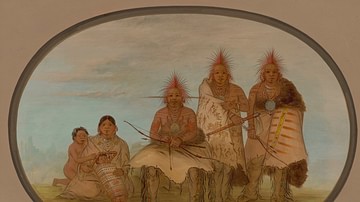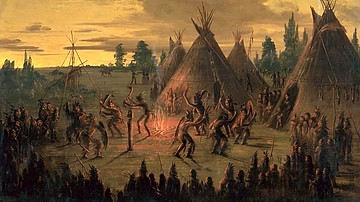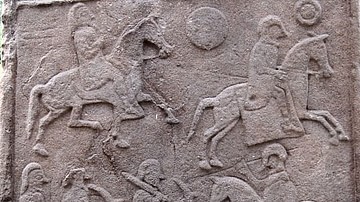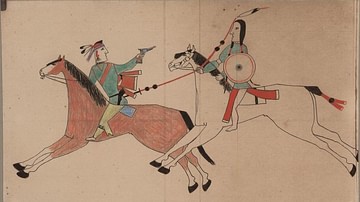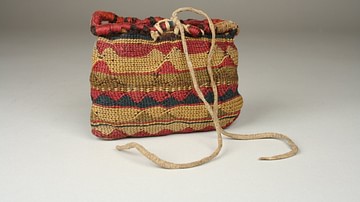The Dun Horse is a Pawnee tale about a poor boy and his grandmother, who find an old horse and take it in. The horse turns out to be magical, however, and improves their fortunes considerably. Like many Pawnee legends – and Native American tales generally – the story highlights the importance of kindness and of following instructions.
In Pawnee spiritual belief, the Great Spirit was the Creator God Ti-ra'wa ("Father Above"), who, despite any evidence to the contrary, was always in control of the created world. Aspects of the world that one judged to be "good" or "bad" were only so in one's opinion as no "bad" thing could come from Ti-ra'wa. The wisdom of the elders, and of the natural world, was understood to come from this same source, and so there are many stories of talking animals, or of elder characters, providing instruction which one ignored at one's peril.
In many stories, including the Wihio tales of the Cheyenne and the Iktomi tales of the Sioux, failing to follow instructions leads to failure – or even death – while, in The Dun Horse, the central character is given a second chance by Ti-ra'wa after his failure, learns from his mistake, and is rewarded for his kindness, faithfulness, and courage.
Text
The following is taken from Pawnee Hero Stories and Folk-Tales (1889) by George Bird Grinnell. As in many Native American tales, the number four is repeated as it is understood as sacred, representing the cardinal points of the compass and the spirits who preside over the directions.
I.
Many years ago, there lived in the Pawnee tribe an old woman and her grandson, a boy about sixteen years old. These people had no relations and were very poor. They were so poor that they were despised by the rest of the tribe. They had nothing of their own; and always, after the village started to move the camp from one place to another, these two would stay behind the rest, to look over the old camp, and pick up anything that the other Indians had thrown away, as worn out or useless. In this way they would sometimes get pieces of robes, worn out moccasins with holes in them, and bits of meat.
Now, it happened one day, after the tribe had moved away from the camp, that this old woman and her boy were following along the trail behind the rest, when they came to a miserable old worn-out dun horse, which they supposed had been abandoned by some Indians. He was thin and exhausted, was blind of one eye, had a bad sore back, and one of his forelegs was very much swollen. In fact, he was so worthless that none of the Pawnees had been willing to take the trouble to try to drive him along with them. But when the old woman and her boy came along, the boy said, "Come now, we will take this old horse, for we can make him carry our pack." So, the old woman put her pack on the horse, and drove him along, but he limped and could only go very slowly.
II.
The tribe moved up on the North Platte, until they came to Court House Rock. The two poor Indians followed them and camped with the others. One day while they were here, the young men who had been sent out to look for buffalo, came hurrying into camp and told the chiefs that a large herd of buffalo were near, and that among them was a spotted calf.
The Head Chief of the Pawnees had a very beautiful daughter, and when he heard about the spotted calf, he ordered his old crier to go about through the village and call out that the man who killed the spotted calf should have his daughter for his wife. For a spotted robe is ti-war´-uks-ti—big medicine [spiritual power].
The buffalo were feeding about four miles from the village, and the chiefs decided that the charge should be made from there. In this way, the man who had the fastest horse would be the most likely to kill the calf. Then all the warriors and the young men picked out their best and fastest horses and made ready to start. Among those who prepared for the charge was the poor boy on the old dun horse. But when they saw him, all the rich young braves on their fast horses pointed at him, and said, "Oh, see; there is the horse that is going to catch the spotted calf;" and they laughed at him, so that the poor boy was ashamed, and rode off to one side of the crowd, where he could not hear their jokes and laughter.
When he had ridden off some little way, the horse stopped, and turned his head round, and spoke to the boy. He said, "Take me down to the creek, and plaster me all over with mud. Cover my head and neck and body and legs." When the boy heard the horse speak, he was afraid; but he did as he was told. Then the horse said, "Now mount, but do not ride back to the warriors, who laugh at you because you have such a poor horse. Stay right here, until the word is given to charge." So, the boy stayed there.
And presently all the fine horses were drawn up in line and pranced about and were so eager to go that their riders could hardly hold them in; and at last, the old crier gave the word, "Loo-ah"—Go! Then the Pawnees all leaned forward on their horses and yelled, and away they went. Suddenly, away off to the right, was seen the old dun horse. He did not seem to run. He seemed to sail along like a bird. He passed all the fastest horses, and in a moment, he was among the buffalo. First, he picked out the spotted calf, and charging up alongside of it, U-ra-rish! straight flew the arrow. The calf fell. The boy drew another arrow and killed a fat cow that was running by. Then he dismounted and began to skin the calf before any of the other warriors had come up. But when the rider got off the old dun horse, how changed he was! He pranced about and would hardly stand still near the dead buffalo. His back was all right again; his legs were well and fine; and both his eyes were clear and bright.
The boy skinned the calf and the cow that he had killed, and then he packed all the meat on the horse and put the spotted robe on top of the load, and started back to the camp on foot, leading the dun horse. But even with this heavy load the horse pranced all the time and was no longer scared at everything he saw. On the way to camp, one of the rich young chiefs of the tribe rode up by the boy and offered him twelve good horses for the spotted robe, so that he could marry the Head Chief's beautiful daughter; but the boy laughed at him and would not sell the robe.
Now, while the boy walked to the camp leading the dun horse, most of the warriors rode back, and one of those that came first to the village, went to the old woman, and said to her, "Your grandson has killed the spotted calf." And the old woman said, "Why do you come to tell me this? You ought to be ashamed to make fun of my boy because he is poor." The warrior said, "What I have told you is true," and then he rode away. After a little while another brave rode up to the old woman, and said to her, "Your grandson has killed the spotted calf." Then the old woman began to cry, she felt so badly because everyone made fun of her boy, because he was poor.
Pretty soon the boy came along, leading the horse up to the lodge where he and his grandmother lived. It was a little lodge, just big enough for two, and was made of old pieces of skin that the old woman had picked up and was tied together with strings of rawhide and sinew. It was the meanest and worst lodge in the village. When the old woman saw her boy leading the dun horse with the load of meat and the robes on it, she was very much surprised. The boy said to her, "Here, I have brought you plenty of meat to eat, and here is a robe, that you may have for yourself. Take the meat off the horse." Then the old woman laughed, for her heart was glad. But when she went to take the meat from the horse's back, he snorted and jumped about, and acted like a wild horse. The old woman looked at him in wonder and could hardly believe that it was the same horse. So, the boy had to take off the meat, for the horse would not let the old woman come near him.
III.
That night the horse spoke again to the boy and said, "Wa-ti-hes Chah´-ra-rat wa-ta. To-morrow the Sioux are coming—a large war party. They will attack the village, and you will have a great battle. Now, when the Sioux are drawn up in line of battle, and are all ready to fight, you jump on to me, and ride as hard as you can, right into the middle of the Sioux, and up to their Head Chief, their greatest warrior, and count coup on him, and kill him, and then ride back. Do this four times, and count coup on four of the bravest Sioux, and kill them, but don't go again. If you go the fifth time, maybe you will be killed, or else you will lose me. La-ku´-ta-chix—remember." So, the boy promised.
The next day it happened as the horse had said, and the Sioux came down and formed a line of battle. Then the boy took his bow and arrows, and jumped on the dun horse, and charged into the midst of them. And when the Sioux saw that he was going to strike their Head Chief, they all shot their arrows at him, and the arrows flew so thickly across each other that the sky became dark, but none of them hit the boy. And he counted coup on the Chief, and killed him, and then rode back. After that he charged again among the Sioux, where they were gathered thickest, and counted coup on their bravest warrior, and killed him. And then twice more, until he had gone four times as the horse had told him.
But the Sioux and the Pawnees kept on fighting, and the boy stood around and watched the battle. And at last, he said to himself, "I have been four times and have killed four Sioux, and I am all right, I am not hurt anywhere; why may I not go again?" So, he jumped on the dun horse, and charged again. But when he got among the Sioux, one Sioux warrior drew an arrow and shot. The arrow struck the dun horse behind the forelegs and pierced him through. And the horse fell down dead. But the boy jumped off, and fought his way through the Sioux, and ran away as fast as he could to the Pawnees. Now, as soon as the horse was killed, the Sioux said to each other, "This horse was like a man. He was brave. He was not like a horse." And they took their knives and hatchets, and hacked the dun horse and gashed his flesh, and cut him into small pieces.
The Pawnees and Sioux fought all day long, but toward night the Sioux broke and fled.
IV.
The boy felt very badly that he had lost his horse; and, after the fight was over, he went out from the village to where it had taken place, to mourn for his horse. He went to the spot where the horse lay, and gathered up all the pieces of flesh, which the Sioux had cut off, and the legs and the hoofs, and put them all together in a pile. Then he went off to the top of a hill nearby and sat down and drew his robe over his head and began to mourn for his horse.
As he sat there, he heard a great windstorm coming up, and it passed over him with a loud rushing sound, and after the wind came a rain. The boy looked down from where he sat to the pile of flesh and bones, which was all that was left of his horse, and he could just see it through the rain. And the rain passed by, and his heart was very heavy, and he kept on mourning.
And pretty soon, came another rushing wind, and after it a rain; and as he looked through the driving rain toward the spot where the pieces lay, he thought that they seemed to come together and take shape, and that the pile looked like a horse lying down, but he could not see well for the thick rain.
After this, came a third storm like the others; and now when he looked toward the horse, he thought he saw its tail move from side to side two or three times, and that it lifted its head from the ground. The boy was afraid, and wanted to run away, but he stayed.
And as he waited, there came another storm. And while the rain fell, looking through the rain, the boy saw the horse raise himself up on his forelegs and look about. Then the dun horse stood up.
V.
The boy left the place where he had been sitting on the hilltop and went down to him. When the boy had come near to him, the horse spoke and said, "You have seen how it has been this day; and from this you may know how it will be after this. But Ti-ra´-wa has been good and has let me come back to you. After this, do what I tell you; not any more, not any less." Then the horse said, "Now lead me off, far away from the camp, behind that big hill, and leave me there to-night, and in the morning come for me;" and the boy did as he was told.
And when he went for the horse in the morning, he found with him a beautiful white gelding, much more handsome than any horse in the tribe. That night the dun horse told the boy to take him again to the place behind the big hill, and to come for him the next morning; and when the boy went for him again, he found with him a beautiful black gelding. And so for ten nights, he left the horse among the hills, and each morning he found a different colored horse, a bay, a roan, a gray, a blue, a spotted horse, and all of them finer than any horses that the Pawnees had ever had in their tribe before.
Now the boy was rich, and he married the beautiful daughter of the Head Chief, and when he became older, he was made Head Chief himself. He had many children by his beautiful wife, and one day when his oldest boy died, he wrapped him in the spotted calf robe and buried him in it. He always took good care of his old grandmother and kept her in his own lodge until she died. The dun horse was never ridden except at feasts, and when they were going to have a doctors' dance, but he was always led about with the Chief, wherever he went. The horse lived in the village for many years, until he became very old. And at last, he died.

